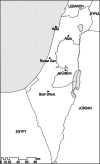Recent trends in the epidemiology of shigellosis in Israel
- PMID: 24559503
- PMCID: PMC9151250
- DOI: 10.1017/S0950268814000260
Recent trends in the epidemiology of shigellosis in Israel
Abstract
We provide an update on the epidemiology of shigellosis in Israel using data generated by a sentinel laboratory-based surveillance network for the period 1998-2012. The average annual incidence of culture-proven shigellosis was 97/100 000. We estimated that each case of shigellosis accounted for 25 cases in the community indicating the high burden of disease. Orthodox Jewish communities, living in highly crowded conditions and with a high number of children aged <5 years were the epicentre of country-wide biennial propagated epidemics of S. sonnei shigellosis. S. flexneri was the leading Shigella serogroup in Israeli Arabs. S. flexneri 2a and S. flexneri 6 alternated as the most common serotypes. Both S. sonnei and S. flexneri isolates showed high rates of resistance to ampicillin and trimethoprim/sulfamethoxazole and very low rates of resistance to quinolones and third-generation cephalosporins. Shigellosis due to S. sonnei conferred 81% (95% confidence interval 69-89) protection against the homologous Shigella serotype when epidemic exposure re-occurred 2 years later. These data are of value in the process of Shigella vaccine development.
Figures







Similar articles
-
Twenty-five years of sentinel laboratory-based surveillance of shigellosis in a high-income country endemic for the disease, Israel, 1998 to 2022.Euro Surveill. 2024 Aug;29(31):2400022. doi: 10.2807/1560-7917.ES.2024.29.31.2400022. Euro Surveill. 2024. PMID: 39092530 Free PMC article.
-
Burden and risk factors of Shigella sonnei shigellosis among children aged 0-59 months in hyperendemic communities in Israel.Int J Infect Dis. 2019 May;82:117-123. doi: 10.1016/j.ijid.2019.02.031. Epub 2019 Mar 1. Int J Infect Dis. 2019. PMID: 30831222
-
Global burden of Shigella infections: implications for vaccine development and implementation of control strategies.Bull World Health Organ. 1999;77(8):651-66. Bull World Health Organ. 1999. PMID: 10516787 Free PMC article.
-
Shigellosis in Taiwan: An old enteric pathogen with changing epidemiology and increasing antimicrobial resistance.J Microbiol Immunol Infect. 2024 Jun;57(3):346-353. doi: 10.1016/j.jmii.2023.10.015. Epub 2023 Nov 3. J Microbiol Immunol Infect. 2024. PMID: 37951802 Review.
-
Shigellosis.J Microbiol. 2005 Apr;43(2):133-43. J Microbiol. 2005. PMID: 15880088 Review.
Cited by
-
Toward a Shigella Vaccine: Opportunities and Challenges to Fight an Antimicrobial-Resistant Pathogen.Int J Mol Sci. 2023 Feb 28;24(5):4649. doi: 10.3390/ijms24054649. Int J Mol Sci. 2023. PMID: 36902092 Free PMC article. Review.
-
A next-generation GMMA-based vaccine candidate to fight shigellosis.NPJ Vaccines. 2023 Sep 5;8(1):130. doi: 10.1038/s41541-023-00725-8. NPJ Vaccines. 2023. PMID: 37670042 Free PMC article.
-
The changing epidemiology of shigellosis in Australia, 2001-2019.PLoS Negl Trop Dis. 2023 Mar 1;17(3):e0010450. doi: 10.1371/journal.pntd.0010450. eCollection 2023 Mar. PLoS Negl Trop Dis. 2023. PMID: 36857390 Free PMC article.
-
Early Childhood Shigellosis and Attention Deficit Hyperactivity Disorder: A Population-Based Cohort Study with a Prolonged Follow-up.J Atten Disord. 2021 Nov;25(13):1791-1800. doi: 10.1177/1087054720940392. Epub 2020 Jul 23. J Atten Disord. 2021. PMID: 32698643 Free PMC article.
-
Twenty-five years of sentinel laboratory-based surveillance of shigellosis in a high-income country endemic for the disease, Israel, 1998 to 2022.Euro Surveill. 2024 Aug;29(31):2400022. doi: 10.2807/1560-7917.ES.2024.29.31.2400022. Euro Surveill. 2024. PMID: 39092530 Free PMC article.
References
-
- Voetsch AC, et al. Laboratory practices for stool-specimen culture for bacterial pathogens, including Escherichia coli O157:H7, in the FoodNet sites, 1995–2000. Clinical Infectious Diseases 2004; 38 (Suppl. 3): S190–197. - PubMed
-
- Niyogi SK. Shigellosis. Journal of Microbiology 2005; 43: 133–143. - PubMed
-
- Ahmed F, et al. Epidemiology of post-shigellosis persistent diarrhea in young children. Pediatric Infectious Disease Journal 2001; 20: 525–530. - PubMed
Publication types
MeSH terms
Substances
LinkOut - more resources
Full Text Sources
Other Literature Sources

